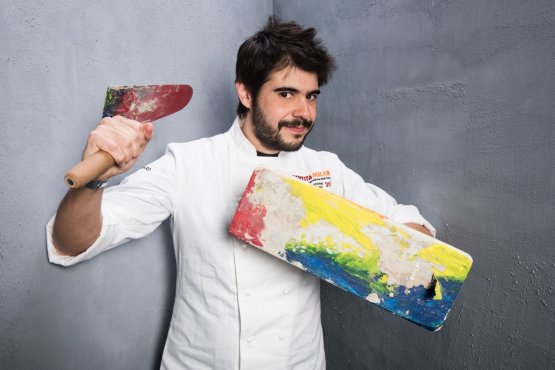see part one
The pillars of this dish could appear to be the result of a controversial choice. Castoreum is an essence extracted thanks to the alcoholic dyeing of the beavers glands, an animal which, in the Fifties, risked extinction because of the reckless hunt for its fur, which today is fortunately ruled by international laws. Formica rufa, is also in the red list of the species needing protection and is instead threatened by invasive actions in the wood ecosystem.
Then there’s the roe deer heart. We soak it in a solution of salted water and ice. We then drain the blood for a few ours. It is then dried and later smoked at cold temperature for 4 hours with wood, juniper berries and liquorish root. Just before serving, it is brushed with a macerated oil made with the infusion at 45°C of propolis and fresh juniper berries in olive oil, the only Mediterranean note that makes me go back to my roots for a second.

Roberto Flore, Sardinian, from Seneghe, head chef at the Nordic Food Lab (photo credits Brambilla/Serrani)
Recreating the earth in the undergrowth faithfully is no simple task yet it can be done, with a little creativity. The decomposition process could be associated to that of fermentation, in which microorganisms decompose matter, modifying it. We use a special paste of fermented mushrooms created a while ago at the
Nordic Food Lab: for the fermentation we use
Aspergillus orizae, commonly known as
koji, which grows on top of barley.
We add the syrup, made by reducing the lymph extracted from the birch tree, its lyophilised leaves, the lichen dye and some fresh juniper berries to the fermented paste. We add active carbon, which adds a mineral taste and a grainy feeling similar to that of the earth. We finish with pure essence of formica rufa. This insect, which is essential to keep the wood and the undergrowth healthy, creates large nests, capable of visually marking the landscape.
The aroma resulting from the formic acid naturally produced by the ants, used as a defence weapon, allows us to speak about the safeguard of the biodiversity in our territory, showing the value of the elements composing it from a different perspective. The berries are frozen in liquid nitrogen as soon as they are picked and then lyophilised. Elderberries are fermented in a wine made with elderberry flowers and, later, acidified by adding acetic bacteria. The temperature reached in the fermentation is enough to make sure that the cyanide in the berries will evaporate.
When this process is completed, the berries are dehydrated at 45°C, and thus acquire the typical acid note recalling the taste of barley after the malting process. We add a fresh component to the dish, thanks to wild garlic sprouts, winter watercress and horse radish root. We finish the dish by nuking some pieces of lyophilised leaf, the alcoholic dye extracted from the beaver and that of the birch sprouts.
2. the end